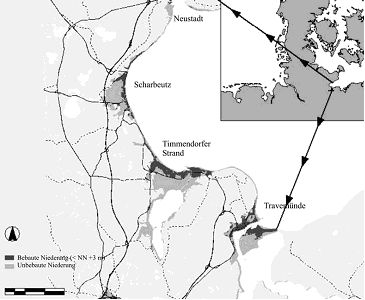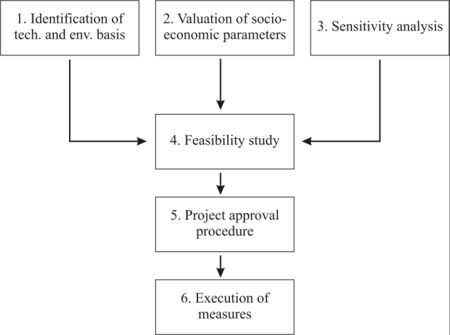ICZM-Best practice case study in the Bay of Luebeck
Contents
Project region

The study at hand concentrates on two municipalities situated at the Bay of Lübeck along the Western Baltic Sea coast in Germany (Fig. 1). They are called Timmendorfer Strand and Scharbeutz and they are two respected coastal holiday resorts.
The area is characterized by two spits that separate former lagoons from the Baltic Sea. These spits have a mean elevation of about 2.5-3.0 meters above mean sea level (MSL) and are intensively built-up areas. One former lagoon still is occupied by a lake, in the other, marshes developed that are nowadays drained and cultivated extensively. Littoral currents transport significant amounts of sand from the nearby cliffs into the bight, which has a quite stable coastline as result (Hofstede, 2001[2]).
Initial problem
The coastal defence system of the area is described as inadequately, since only the spit system protects all inhabitants in the 12.6 square kilometres large coastal lowland (Hofstede, 2004[3]). Since more than 40 years it was discussed in the municipalities of Timmendorfer Strand and Scharbeutz, if and in what way measures of coastal defence should be conducted (Kaul and Reins, 2000[4]). On the one side of the discussion were municipalities, which were responsible for flood defence. They pointed out the hazard and proposed technical solutions such as the built-up of a sea wall on the beach. On the other side of the discussion stood the local community. It met the proposal of the municipality with great scepticism because it was strongly depending on the beach as the main tourist attraction and therewith source of income (Hofstede, 2001[2]).
Project aims
The aim of the project was to overcome this deadlock situation. It was obvious that this could only be achieved with active participation and acceptance of the local population. Taking this as aim, the two municipalities together with the Ministry of Rural Areas, Agriculture, Regional Planning and Tourism (‘Ministerium für Ländliche Räume, Landwirtschaft, Landesplanung und Tourismus; MLR) and the Office For Rural Areas (‘Amt für ländliche Räume’; ALR) of Schleswig-Holstein decided to develop an integrative coastal defence concept for the lowlands of Timmendorfer Strand and Scharbeutz (Hofstede, 2001[2]). It was strived for a solution which protects human lives and human assets.
Project performance
In order to follow the performance of the project, it is crucial to mention a striking characteristic of the project. In the strict sense, the activities in Timmendorfer Strand and Scharbeutz are not a matter of pure ICZM. The major reason therefore is that coastal protection issues in Schleswig-Holstein obtain priority before other sectors such as tourism or nature conservation (see MLR, 2001[5]). Therewith it is debatable to which extent the project can fulfil the ‘I’ of ICZM, thus to which extent the project can be of pure integrative nature. Consequently, one would have to speak about a practical measure of coastal protection using an ICZM approach. For reasons of simplification, the project will be referred to as an ICZM project, but without neglecting its specific characteristic.
The project performance can be divided into six main steps (Fig. 2) , which are identification of technical and environmental basics, valuation of socio-economic parameters, sensitivity analysis, feasibility study, project approval procedure, and execution of measures (Reese et al., 2001[6]).

First step of the project was a stocktaking of technical and environmental basics. It comprises examinations of the natural and anthropogenic conditions in the field of hydrography and morphology and results in modelling potential flood plains of the investigation area. The result of the examination is that the coastal area of Timmendorfer Strand and Scharbeutz is significant endangered by storm surges. Further, humans lives and assets are highly endangered (see Reese et al., 2001[6]). Based on this result, an analysis of the precise socio-economic values was conducted (second step). This valuation calculated the monetary values of flooding risks on human lives and assets along the potential flood plains. For that purpose the number of endangered inhabitants, employment, tourist beds, and monetary values (such as housing, traffic sites, agricultural sites, and forest sites) were taken into consideration. Finally, an estimated capital asset from about 1.8 billion Euros is provided in the two municipalities (Reese et al., 2001[6]). The sensitivity analysis (third step) forms the heart of the project. It is based on cybernetically evaluations of complex systems according to Vester (2002[7]). In Timmendorfer Strand and Scharbeutz, a public meeting was organised by the mayors of the municipalities to which all affected persons as well as local boards and councils were invited. About 65 persons, mostly representatives from affected local interest groups and municipal representatives, attended the meeting (Hamann, 2007[8]). After being informed about the problematic situation and the need for action, the sensitivity analysis was explained and conducted in two phases with the help of a professional and independent consultant company.
The first phase comprised five meetings (with 20-25 participants each) over a period of four month. The participants mapped the coastal system of Timmendorfer Strand and Scharbeutz in a conceptual model where the most important 17 variables (e.g. economic power, coastal protection, living) are pulled together (see Kaul and Reins, 2000[4]). The model allowed analysing the interactions between the variables.
The second phase ran over a period of two months and comprised four meetings. It aimed at giving preference to one out of five coastal defence strategies developed. The range went from a zero option where no coastal defence is executed to a maximal option where a primary state dike is built on the beach (see Kaul and Reins, 2000[4]). After the input of various defence strategies and an interlinkage of future sea level rise into the model, the impacts for each variable were simulated. These simulations formed the basis for discussions among all participants. These discussions finally led to the best option for the community: a mixed strategy where coastal protection and maintenance of natural scenery are combined (Hofstede, 2001[2]).
The consensus of the sensitivity analysis formed the basis for the conduction of a feasibility study (fourth step). Therefore, four consultant offices were chosen to develop innovative ideas on an integrative coastal defence solution which fulfils the requirements of the sensitivity analysis. The award-winning solution envisioned a deep-grounded flood protection wall which fit to the characteristically scenery of the beach promenade. Only a peak of 80 centimetres should be visible above ground level by which one side of the wall should be covered visually by dunes and the other side constitutes the boundary of the beach promenade (see Hofstede, 2004[3]). The fifth step constituted a routine processing of a coastal defence project, namely approval process according to the Aquatic Law of Schleswig-Holstein (‘Landeswassergesetz’). As a result, sanction was given to the project application (Riemer, 2007[6]).
Finally, the two municipalities Timmendorfer Strand and Scharbeutz started executing the measures (sixth step). The construction of about ten kilometres sea wall is not finished to date. One reason for the delay can be seen in changing requirements. New calculations hold the result that the sea wall has to be heightened from 80 to about 180 centimetres on a section of about 100 metres (Riemer, 2007[6]).
Project evaluation
The strengths, weaknesses, opportunities, and threats of ‘ICZM-Bay of Lübeck’ (Tab. 1):
| SWOT | Description |
|---|---|
| Strength |
|
| Weakness |
|
| Opportunity |
|
| Threat |
|
References
- ↑ Hofstede, J. and Hamann, M., 2002. Integrated Management of Coastal Defence in Schleswig-Holstein: Experience and Challenge. In: G. Schernewski and U. Schiewer (Editors), Baltic Coastal Ecosystems: Structure, function and coastal zone management. Central Eastern development Studies. Springer, Berlin, pp. 377-388.
- ↑ 2.0 2.1 2.2 2.3 Hofstede, J. 2001. Participatory planning in coastal defence: A pilot study from the Baltic Sea coast of Germany. Conference proceedings. Paper presented at "36th Annual Conference of River and Coastal Engineers". Conference at 20.-22.06.2001, London.
- ↑ 3.0 3.1 Hofstede, J. 2004. Timmendorfer Strand und Scharbeutz: zwei Ostseegemeinden schützen sich vor Klimaänderungen. Unpublished conference proceedings. Paper presented at "Klimaänderung und Küstenschutz". Conference at 29.-30.11.2004, Kiel.
- ↑ 4.0 4.1 4.2 Kaul, J. and Reins, C., 2000. Abschlußbericht der Sensitivitätsanalyse zu einem Integrierten Küstenschutzkonzept für die 'Küstenniederung Timmendorfer Strand / Scharbeutz', Kaul & Reins GbR, Kiel, pp. 50.
- ↑ MLR, 2001. Generalplan Küstenschutz. Integriertes Küstenschutzmanagement in Schleswig-Holstein, MLR, Kiel, pp. 70.
- ↑ 6.0 6.1 6.2 6.3 6.4 6.5 Reese, S., Markau, H. and Sterr, H., 2001. Wertermittlung hochwassergefährdeter Gebiete in den Gemeinden Scharbeutz und Timmendorfer Strand, Forschungs- und Technologiezentrum Westküste, Büsum, pp. 63. Cite error: Invalid
<ref>tag; name "r1" defined multiple times with different content - ↑ Vester, F., 2002. Die Kunst vernetzt zu denken. Deutscher Taschenbuch Verlag, Munich, pp. 372.
- ↑ Hamann, M., 2007. Ministry of the Interior Schleswig-Holstein, Department of civil protection, Kiel. Personal communication at 26.11.2007.
See also
Internal Links
- Lessons learned from three ICZM best-practice projects
- ICZM-Best practice case study in the Oder estuary
- ICZM-Best practice case study in Western Zeelandic-Flanders
- Lessons learned from ICZM in Belgium, The Netherlands and the United Kingdom
- Analysis of the ICZM process in Belgium
- Analysis of the ICZM process in The Netherlands
- Analysis of the ICZM process in the United Kingdom
- Guidelines for Integrated Coastal Zone Management (ICZM) in Germany
External Links
- The present study was performed within the frame of a Diploma thesis at the Technical University Berlin which was published as ICZM-Odra report no. 44, ISSN 1614-5968 download
Please note that others may also have edited the contents of this article.
|